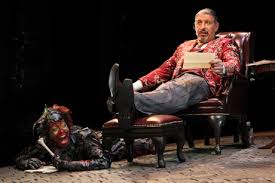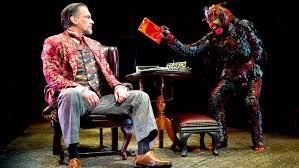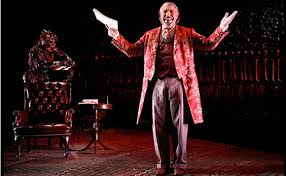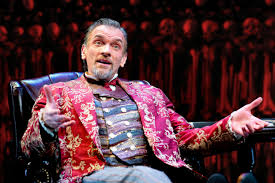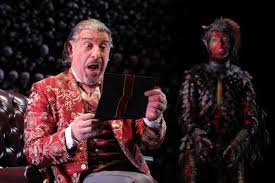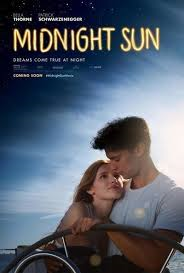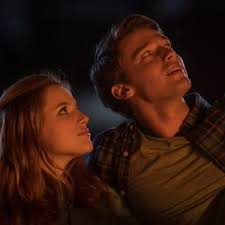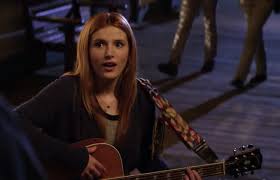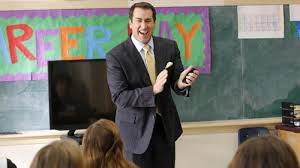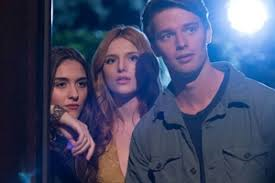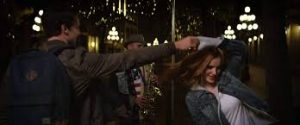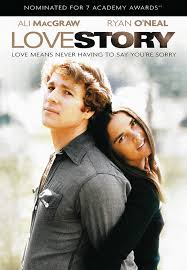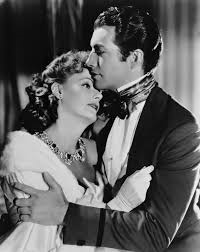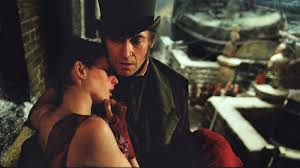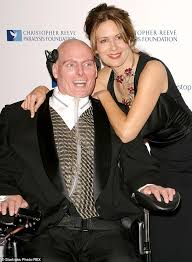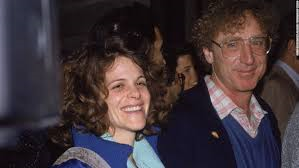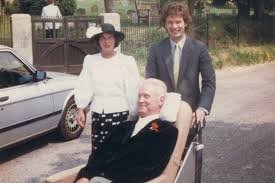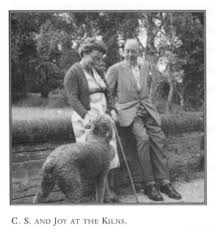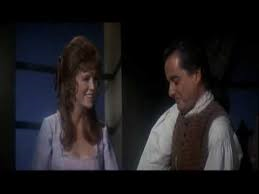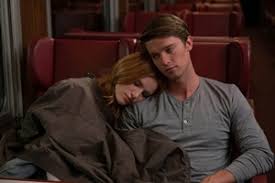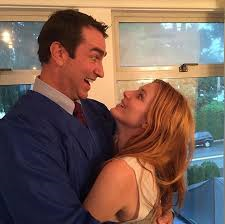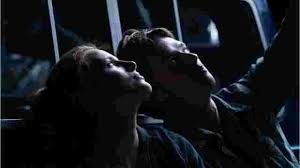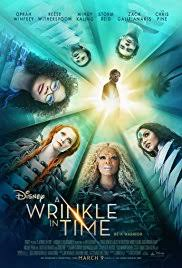
SHORT TAKE:
Child's classic story brutally stripped of all vestiges of the originally intended Christian allegory, amateurishly directed with irritatingly constant close-ups, lackluster adult performances, and distractingly stupid costumes. This new A Wrinkle in Time is a glittering dead heap of New Age pseudo-philosophical jargon. But the kids were cute.
LONG TAKE:
To say this movie was a disappointment would be one of this year’s great understatements. To say it was a laughably bad movie would be falling short of a full expose. To say it was offensive to Christianity in general and the Christian faith of its author would not be amiss. There is so much wrong with the new movie titled A Wrinkle in Time (it would be an insult to the source material to call it a filmed version of the book) that I have to do it by category.
Unlike most awards shows or Johnny Carson’s "lists" I will start with the most important first.
The ORIGINAL BOOK premise is that a teenaged girl, her friend Calvin and genius little brother go on a quest to find the teenaged girl’s father. The father, Mr Murray, was captured four years before by a great ubiquitous evil (presumably original sin) while trying to travel through the universe by "wrinkling" space with his mind. The time "wrinkle" of the title is supposed to work the same way and allows them to get back five minutes after their adventure begins. The children are aided by off-world/other-wordly angel-like creatures who masquerade as Mrs. Who, Mrs. Whatzit, and Mrs. Which, quirky little old ladies here on Earth.
THEME
Book
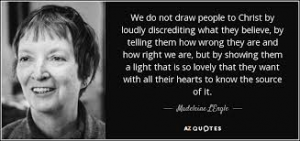 The author Madeleine L’Engle was a devout Christian. She served as the librarian and writer in residence at New York City’s John the Divine Episcopalian church and her faith informed everything she wrote. Sarah Arthur, author of a biography on Madeleine L’Engle expressed it this way: "It was the wonder and humility of scientists, especially theoretical physicists like Max Planck and Albert Einstein, who eventually convinced [L’Engle] to become Christian. If the Creator of a vast and surprising cosmos could love this small planet enough to become one of us…that was a faith worth clinging to." L’Engle herself is quoted in a 1979 interview with Christianity Today: "I believe we can understand cosmic questions only through particulars. I can only understand God through one specific particular, the incarnation of Jesus of Nazareth." Then, again, in case there is any vestige of doubt as to her perception of Jesus: "To believe that this Creator took on human vesture, accepted death and mortality, was tempted, betrayed, broken, and all for love of us, defies reason. It is so wild that it terrifies some Christians [this]…wild wonder of God’s love, a love we don’t even have to earn."
The author Madeleine L’Engle was a devout Christian. She served as the librarian and writer in residence at New York City’s John the Divine Episcopalian church and her faith informed everything she wrote. Sarah Arthur, author of a biography on Madeleine L’Engle expressed it this way: "It was the wonder and humility of scientists, especially theoretical physicists like Max Planck and Albert Einstein, who eventually convinced [L’Engle] to become Christian. If the Creator of a vast and surprising cosmos could love this small planet enough to become one of us…that was a faith worth clinging to." L’Engle herself is quoted in a 1979 interview with Christianity Today: "I believe we can understand cosmic questions only through particulars. I can only understand God through one specific particular, the incarnation of Jesus of Nazareth." Then, again, in case there is any vestige of doubt as to her perception of Jesus: "To believe that this Creator took on human vesture, accepted death and mortality, was tempted, betrayed, broken, and all for love of us, defies reason. It is so wild that it terrifies some Christians [this]…wild wonder of God’s love, a love we don’t even have to earn."
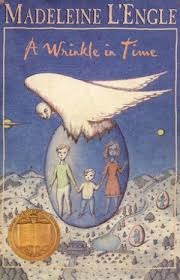 Keep in mind I was never a fan of this author or this book. Nothing against either – I had just never read anything of L’Engle’s until I blitzed A.W.I.T. to get perspective on the movie. It quickly becomes obvious, to even the casual observer or non-believer, that L’Engle intended a CS Lewis-style Christian allegory.
Keep in mind I was never a fan of this author or this book. Nothing against either – I had just never read anything of L’Engle’s until I blitzed A.W.I.T. to get perspective on the movie. It quickly becomes obvious, to even the casual observer or non-believer, that L’Engle intended a CS Lewis-style Christian allegory.
For example, the angel-like winged creatures which inhabit the origin planet of the three other-worldy Mrs. W’s fly and dance singing constantly. What they sing is: "Sing unto the Lord a new song, and his praise from the ends of the earth, ye that go down to the sea…the isles…the inhabitants…the wilderness…the cities…the rock…let them shout from the top of the mountains. Let them give glory unto the Lord."
When the three Mrs. W’s explain to the children they will be fighting a terrible evil darkness, they ask who they can think of on Earth who has fought the darkness. Mrs. Who herself quotes John 1: 5, "And the light shineth in darkness; and the darkness comprehended it not." To which one of the children immediately shouts: "Jesus! … Why of course, Jesus!" Mrs. Who then asks the children who else might be those who fight against the darkness and the list is: Leonardo da Vinci, Michelangelo, Shakespeare, Bach, Pasteur, Curie, Einstein, Schweitzer, Gandhi, Buddha, Beethoven, Rembrandt, St. Francis, Euclid, and Copernicus. All of these are people who have fought and some who died to alleviate suffering, bring beauty into the world, and help comprehend the intricacies of the world’s Intelligently Created order.
Mrs. Who usually speaks in quotes of the famous: Shakespeare "We are such stuff as dreams are made of", Pascal, Dante, Seneca, Perez, Horace, Cervantes "Experience is the mother of knowledge", Delille "How small is the Earth to him who looks from Heaven", Euripides "Nothing is hopeless, we must hope for everything", the Bible, and Goethe – the Good Book plus European and British poets, philosophers and authors. She speaks in: English, Latin, Italian, Spanish, German, French, Portugese and Greek.
Movie
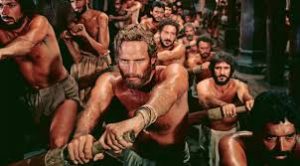 In 1959 Charlton Heston starred in Ben Hur – a movie about an unjustly imprisoned man and his family who,
In 1959 Charlton Heston starred in Ben Hur – a movie about an unjustly imprisoned man and his family who,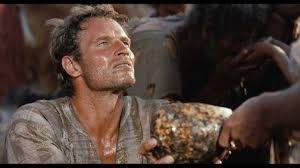
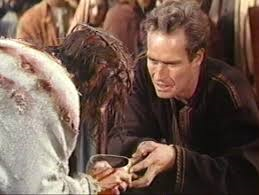 through direct encounters with Christ, are redeemed, learn forgiveness, and find healing in soul and body.
through direct encounters with Christ, are redeemed, learn forgiveness, and find healing in soul and body. 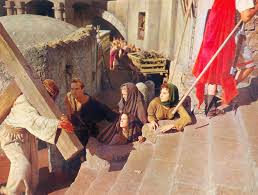 At the end of the movie the main character’s sister and mother, diseased with leprosy, are cured by touching the blood which flowed from Christ on the Cross through the rivulets of water during the storm following Jesus’ death. There is no question, as John Wayne’s character said in The Greatest Story Ever Told: "Truly this man was the Son of God." That was back in the day when even establishment Hollywood knew how to make a religious movie, when practicing Jewish producers, directors and writers respected the faith of their Christian brethren and vica versa.
At the end of the movie the main character’s sister and mother, diseased with leprosy, are cured by touching the blood which flowed from Christ on the Cross through the rivulets of water during the storm following Jesus’ death. There is no question, as John Wayne’s character said in The Greatest Story Ever Told: "Truly this man was the Son of God." That was back in the day when even establishment Hollywood knew how to make a religious movie, when practicing Jewish producers, directors and writers respected the faith of their Christian brethren and vica versa.
In 2006 Ben Hur was divested of all reference to the Divinity of Jesus and reduced the character to —- well, 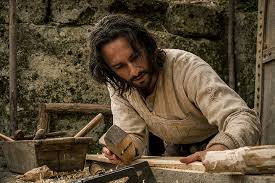 he was a very nice man. No cure for the sister and mother, no major revelations.
he was a very nice man. No cure for the sister and mother, no major revelations.
New Ben Hur was disappointing at best, offensive at worse, right? But 2006's Ben Hur was by far a more theologically rich movie than 2018's travesty of A Wrinkle in Time because in the 2006 Ben Hur at least Jesus makes a guest appearance!
This 2018 A.W.I.T. is a twisting of the classic children’s book which skins and strips the living Christianity out of every iota of the story until it is a glittering dead heap of new age pseudo-philosophical jargon.
 In Mrs. Who’s quotes they replace Pascal (mathematician), Dante (theological poet) – two extremely devout Christians, and Euripides – a classic Greek playwright whose works have survived the test of 2,500 years of time, with Gilbran, a popular but vague and muddled cult writer whose theology is so muddled together in an ecclectic stew of ideas as to be indecipherable, Rumi – a Muslim poet, included, no doubt in a syncophantic bow to Hollywood’s god of diversity, and ……. Chris Tucker "Dang". Chris Tucker? "Dang" is a quote? REALLY? How "in the face" of Western European Classic culture with a middle finger can you get than including a "quote" by a flash in the pan American comedian? And Outkast – they quote Outkast "You need to git out, git up and git something" – a modern American HIP HOP group! And Miranda from the pathetic excuse for a historic musical, Hamilton "Tomorrow they'll (sic) be more of us". Even their Shakespeare is vapid "When shall we three meet again" and is spoken by the EVIL WITCHES FROM MACBETH!!! How dumb are these people? They're having the good guys quote Satanically evil bad guys. Or maybe they knew exactly what they were doing and subtley endorsing the very evil the heroes of this story are supposed to be fighting!
In Mrs. Who’s quotes they replace Pascal (mathematician), Dante (theological poet) – two extremely devout Christians, and Euripides – a classic Greek playwright whose works have survived the test of 2,500 years of time, with Gilbran, a popular but vague and muddled cult writer whose theology is so muddled together in an ecclectic stew of ideas as to be indecipherable, Rumi – a Muslim poet, included, no doubt in a syncophantic bow to Hollywood’s god of diversity, and ……. Chris Tucker "Dang". Chris Tucker? "Dang" is a quote? REALLY? How "in the face" of Western European Classic culture with a middle finger can you get than including a "quote" by a flash in the pan American comedian? And Outkast – they quote Outkast "You need to git out, git up and git something" – a modern American HIP HOP group! And Miranda from the pathetic excuse for a historic musical, Hamilton "Tomorrow they'll (sic) be more of us". Even their Shakespeare is vapid "When shall we three meet again" and is spoken by the EVIL WITCHES FROM MACBETH!!! How dumb are these people? They're having the good guys quote Satanically evil bad guys. Or maybe they knew exactly what they were doing and subtley endorsing the very evil the heroes of this story are supposed to be fighting!
What is WRONG with them?!? At least quote Americans who have something to say – George Washington, Martin Luther King, Thomas Paine, Booker T. Washington, Emily Dickenson, St. Elizabeth Ann Seton, even Groucho Marx who was at least funny!!!!!
Most egregiously – in the list of those who fight the darkness, Jesus, whose name is mentioned first and with emphasis by Ms. L’Engle and referenced directly and indirectly several other times, is never named. Not — even — once. Not once in the entirety of this whole misbegotten travesty of a movie. The writers of this script do not so much as mention the name of the Son of God for whom this entire book was written.
Instead of sound theology we get new age woman-hood-ness-ish nonsense – everything revolves around Meg and her blossoming into a "warrior", boosting her self-esteem and encouraging her to think better of herself. Do you know who, demographically, are the single group with the highest self-esteem? Career criminals. This is what gets them into trouble. They have little empathy or use for others. They think they are the center of the universe and when the universe, society in general and the criminal justice system disagree they end up in jail. THIS is the model they wish to set up as the New Age Princess? And, I guess, Calvin and her little brother Charles Wallace are disposable because they are boys, as demonstrated by her lack of concern after the rock tornado, as described below. And her father is useless because he "abandoned" them.
SCRIPT
The only thing that moves faster than light is darkness……..um what the HECK does that mean? Darkness is the absence of light, not a thing unto itself. This dumb concept isn’t in the book.
Having taken out all references to Christianity, including the home planet society of angels and their praise and worship of the Living God, the writers had to fill in time with SOMEthing. So they decided on stupid things which did nothing to further the narrative – like a rock tornado which chases the children, during which time the protective Meg incomprehensibly forgets all about her little brother. After the crisis has ended Charles Wallace’s sudden reappearance is taken with a ho hum shrug instead of the hysterical relief it should have merited.
Calvin in the book is always respectful and solicitous of Meg but in the movie has at least one moment of unexplained downright stalk-y creepiness after the rock tornado.
 The movie contains, in a (presumably accidental) scene of accuracy to the book a street full of children who all bounce their balls in unison. Mothers call their children to come in simultaneously. In this scene from the book as well as other scenes in the book which emphasize the concept, Ms. L’Engle exposes the calamity of socialistic and communistic loss of individuality and the evil of the tyrannical requirement of cliquish uniformity. Apparently this hit way too close to home for the writers as the follow ups which made this one street scene make sense were cut out. Gone is the newspaper boy who throws newspapers with exacting rhythmicness, then explains he will be "reprocessed" if he does not. Excised are scenes where people in the downtown area move about in drab and anxious uniformity. I guess it would have expressed the evil of the hive mind too well.
The movie contains, in a (presumably accidental) scene of accuracy to the book a street full of children who all bounce their balls in unison. Mothers call their children to come in simultaneously. In this scene from the book as well as other scenes in the book which emphasize the concept, Ms. L’Engle exposes the calamity of socialistic and communistic loss of individuality and the evil of the tyrannical requirement of cliquish uniformity. Apparently this hit way too close to home for the writers as the follow ups which made this one street scene make sense were cut out. Gone is the newspaper boy who throws newspapers with exacting rhythmicness, then explains he will be "reprocessed" if he does not. Excised are scenes where people in the downtown area move about in drab and anxious uniformity. I guess it would have expressed the evil of the hive mind too well.
DIRECTION
Apparently Ms. DuVernay went to the TV soap opera school of direction because every emotion – be it awe, fear, grief, joy, or surprise, was given a  CLOSE-UP!!!!!!!! I mean a
CLOSE-UP!!!!!!!! I mean a 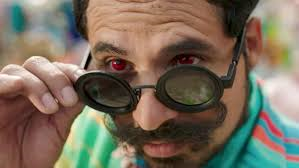 CLOSE-UP!!! so far in that you not only lost most of the top of their head but any connection to whom that person was talking. You get no reaction shots unless you cut to another
CLOSE-UP!!! so far in that you not only lost most of the top of their head but any connection to whom that person was talking. You get no reaction shots unless you cut to another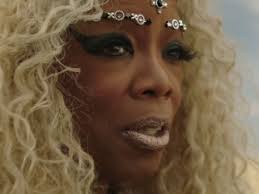 CLOSE-UP!!!!! This gets tiresome after the first three or four
CLOSE-UP!!!!! This gets tiresome after the first three or four 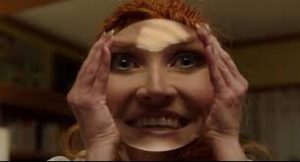 DOZEN times she does this. There were so many
DOZEN times she does this. There were so many  CLOSE-UPS!!!! I thought I was going to get a nose bleed.
CLOSE-UPS!!!! I thought I was going to get a nose bleed.
ACTING
You might laugh at the idea of Oprah Winfrey acting but I’ve seen her do a smashingly good job. 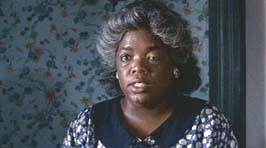
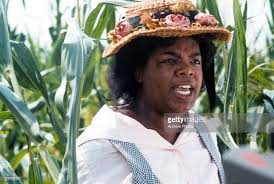 Not only did she do a truly noteworthy job as the abused and abusive wife in The Color Purple, but she didn’t mind looking really ugly, dumpy and every worn mile of her character’s hard life. I thought at the time that she could have a decent career in performance. Alas it was not to be and this cringy amateur-ish mechanical reading of her lines is the result.
Not only did she do a truly noteworthy job as the abused and abusive wife in The Color Purple, but she didn’t mind looking really ugly, dumpy and every worn mile of her character’s hard life. I thought at the time that she could have a decent career in performance. Alas it was not to be and this cringy amateur-ish mechanical reading of her lines is the result.

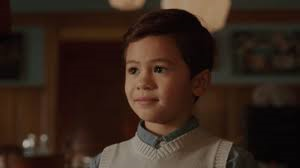 The kids are actually pretty good. I liked them. Not much they could do with the washed out script but Storm Reid was emphathizable as Meg, the grieving daughter, Levi Miller was charming and natural as Calvin, the friend, and Deric McCabe was quite believable as the prodigiously intelligent little brother of Meg, Charles Wallace. Unfortunately, most of the kids’ moments are ruined with the ubiquitous and unrelenting
The kids are actually pretty good. I liked them. Not much they could do with the washed out script but Storm Reid was emphathizable as Meg, the grieving daughter, Levi Miller was charming and natural as Calvin, the friend, and Deric McCabe was quite believable as the prodigiously intelligent little brother of Meg, Charles Wallace. Unfortunately, most of the kids’ moments are ruined with the ubiquitous and unrelenting  CLOSE-UPS!!!!!!
CLOSE-UPS!!!!!!
Chris Pine, who does a terrific job as the new Captain Kirk in the rebooted Star Trek movies, is totally wasted as Mr. Murry, the lost father. All he gets an opportunity to do is weep and look desperately sad in
the lost father. All he gets an opportunity to do is weep and look desperately sad in 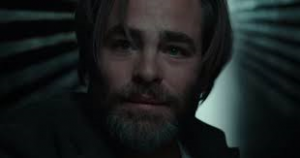 CLOSE-UPS!!!!!
CLOSE-UPS!!!!!
COSTUME
Book
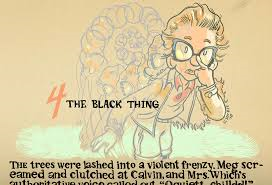 The Mrs. W’s were unassuming, mousey-looking, grandma-like little old ladies, going about their magical business in stealth and modest inconspicuousness. Mrs Whatzsit even goes so far as to "borrow" a neighbor’s sheets to make humble ragamuffin clothes.
The Mrs. W’s were unassuming, mousey-looking, grandma-like little old ladies, going about their magical business in stealth and modest inconspicuousness. Mrs Whatzsit even goes so far as to "borrow" a neighbor’s sheets to make humble ragamuffin clothes.
Movie
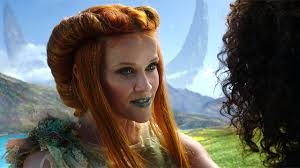 The three "leads" were doodied up like Glenda the Good Witch parading on the Red Carpet during the Oscars. They were dolled up to be young, beautiful, wealthy and ostentatious – the exact opposite of what Ms. L’Engle intended.
The three "leads" were doodied up like Glenda the Good Witch parading on the Red Carpet during the Oscars. They were dolled up to be young, beautiful, wealthy and ostentatious – the exact opposite of what Ms. L’Engle intended.
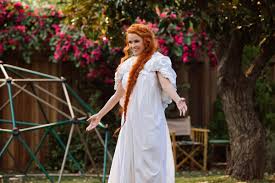 Mrs. Whatzits' sheets, instead of the homemade hodgepodge they were to be intended, look as though they were designed by Yves Saint Laurent.
Mrs. Whatzits' sheets, instead of the homemade hodgepodge they were to be intended, look as though they were designed by Yves Saint Laurent.  Ms. Who wore large flashy bell like get ups I marveled that she didn’t fall and roll in during one scene where she was required to run mincingly down a hill. And Mrs Which – well if you like to see three story high versions of
Ms. Who wore large flashy bell like get ups I marveled that she didn’t fall and roll in during one scene where she was required to run mincingly down a hill. And Mrs Which – well if you like to see three story high versions of 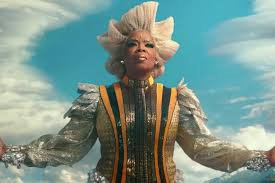 Oprah Winfrey dressed in reject
Oprah Winfrey dressed in reject 
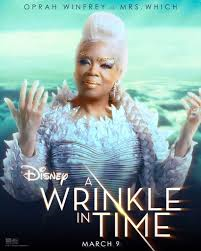 Liberace costumes last used when he was King of Bacchus………
Liberace costumes last used when he was King of Bacchus………
CHARACTERS
Book
In the book, when they arrive at Uriel, the home planet of the Mrs. W’s, Mrs. Who transforms into a creature one might encounter as an angel in CS Lewis’ The Great Divorce. In The Great Divorce, denizens of Purgatory are given a bus tour of Heaven including seeing angels. 
 The creatures of Uriel are much like those angels – powerful and regal, much like a centaur with wings of shimmering filigree that take your breath away.
The creatures of Uriel are much like those angels – powerful and regal, much like a centaur with wings of shimmering filigree that take your breath away.
The Happy Medium is a ploy for Ms. L’Engle to let the children get a safe look at IT, the evil thing which inhabits all of Camazotz and hovers threateningly over Earth, causing strife and pain. The Happy Medium is a simple woman with a crystal ball who prefers to see happy things but willingly helps the Mrs. W’s and the children in a simple projection from her ball.
Movie
 Instead of a majestic angel, Mrs Whatzit turns into a green stingray with the head of an artichoke and
Instead of a majestic angel, Mrs Whatzit turns into a green stingray with the head of an artichoke and drops Calvin in mid-flight. This, of course, does not happen in the book but is another unnecessary waste of celluloid to fill the vacuum where Christianity once shone as the theme.
drops Calvin in mid-flight. This, of course, does not happen in the book but is another unnecessary waste of celluloid to fill the vacuum where Christianity once shone as the theme.
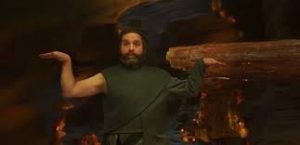 The Happy Medium is a man clown who requires silly ritualistic behaviors to project the needed images –
The Happy Medium is a man clown who requires silly ritualistic behaviors to project the needed images – 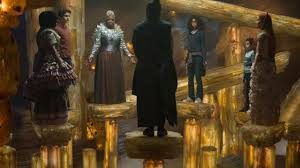 they have to "center" and stand on one foot with their eyes closed on teetering rocks over an abyss – no really this is what he tells them they have to do. I kept expecting him to say he was kidding.
they have to "center" and stand on one foot with their eyes closed on teetering rocks over an abyss – no really this is what he tells them they have to do. I kept expecting him to say he was kidding.
I could go on but I think you get the idea. This movie is a waste of time at best and a destructive piece of brainless propaganda at worst. It's certainly a waste of money.
Go read the book to your kids instead.
 C.S. Lewis’ book The Screwtape Letters – the letters from a senior demon to his nephew/student demon.
C.S. Lewis’ book The Screwtape Letters – the letters from a senior demon to his nephew/student demon.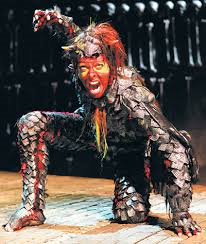 The second inclusion is of Screwtape’s wordless, androgynous assistant demon, Toadpipe, who, in the production we saw, is costumed like an evil Papagano from Mozart’s The Magic Flute, all in artificially colorful feathers from head to toe. He/she has no lines but grunts and growls and pantomimes his/her obsequiousness and occasional little mutinies.
The second inclusion is of Screwtape’s wordless, androgynous assistant demon, Toadpipe, who, in the production we saw, is costumed like an evil Papagano from Mozart’s The Magic Flute, all in artificially colorful feathers from head to toe. He/she has no lines but grunts and growls and pantomimes his/her obsequiousness and occasional little mutinies. Resisting the impulse to root for Screwtape, as the protagonist of the tale, is similar to the same pull of temptation which each of us must continually struggle. This odd conundrum reminds us how easy it would be to find ourselves in the clutches of a Wormwood – or that we might already be in this danger. Fortunately, in Screwtape’s commentaries on his increasing frustrations with the failures of his nephew, we are also shown how to extricate ourselves.
Resisting the impulse to root for Screwtape, as the protagonist of the tale, is similar to the same pull of temptation which each of us must continually struggle. This odd conundrum reminds us how easy it would be to find ourselves in the clutches of a Wormwood – or that we might already be in this danger. Fortunately, in Screwtape’s commentaries on his increasing frustrations with the failures of his nephew, we are also shown how to extricate ourselves. Jeanette and LM George Theater in Houston, but it is only playing through March 17, 2019. However, it will be playing at many future theaters to come and you should catch it when you can. OR a community theater in your locale should contact the Dramatic Publishing Company and see about performing it.
Jeanette and LM George Theater in Houston, but it is only playing through March 17, 2019. However, it will be playing at many future theaters to come and you should catch it when you can. OR a community theater in your locale should contact the Dramatic Publishing Company and see about performing it.

